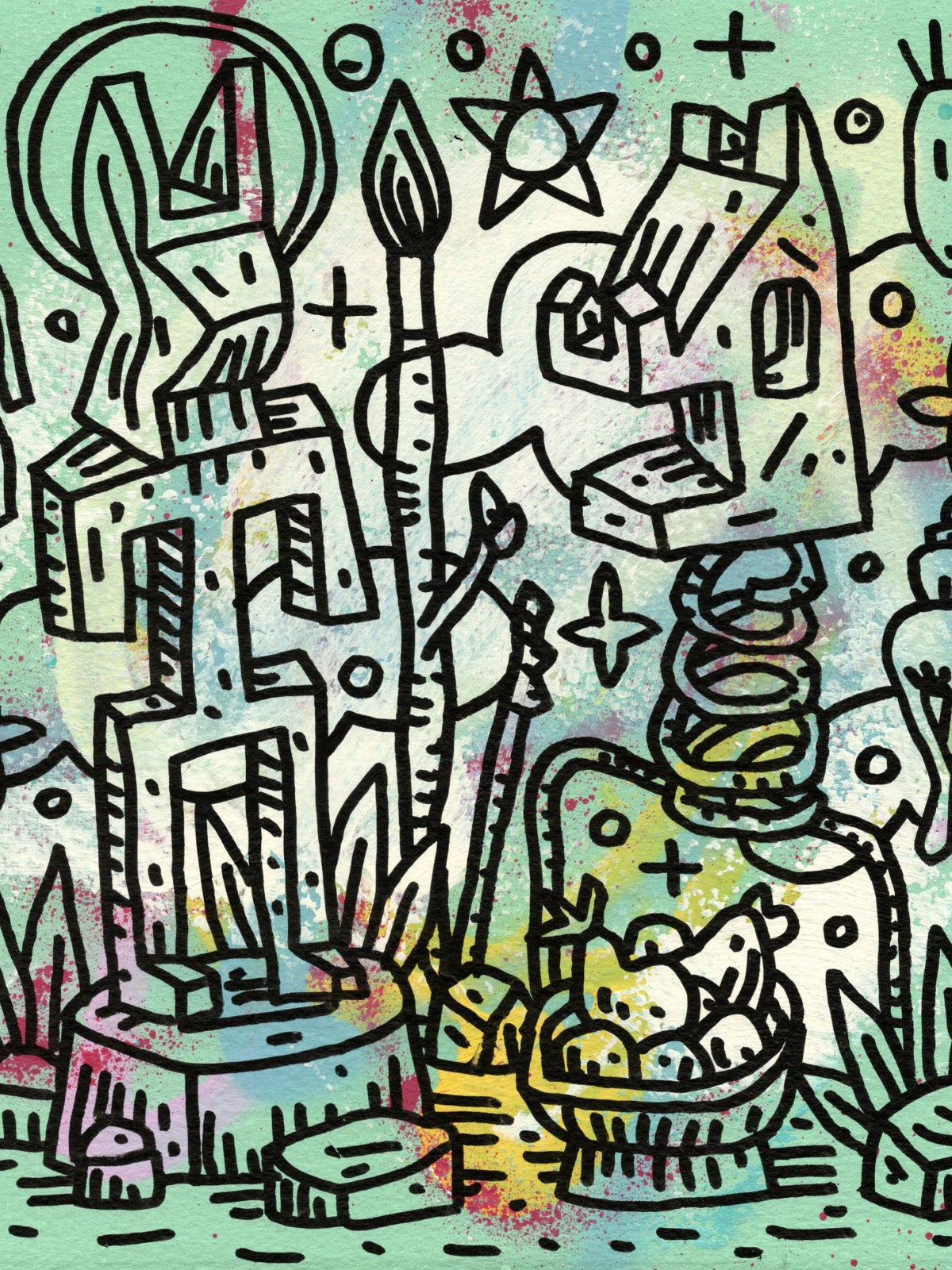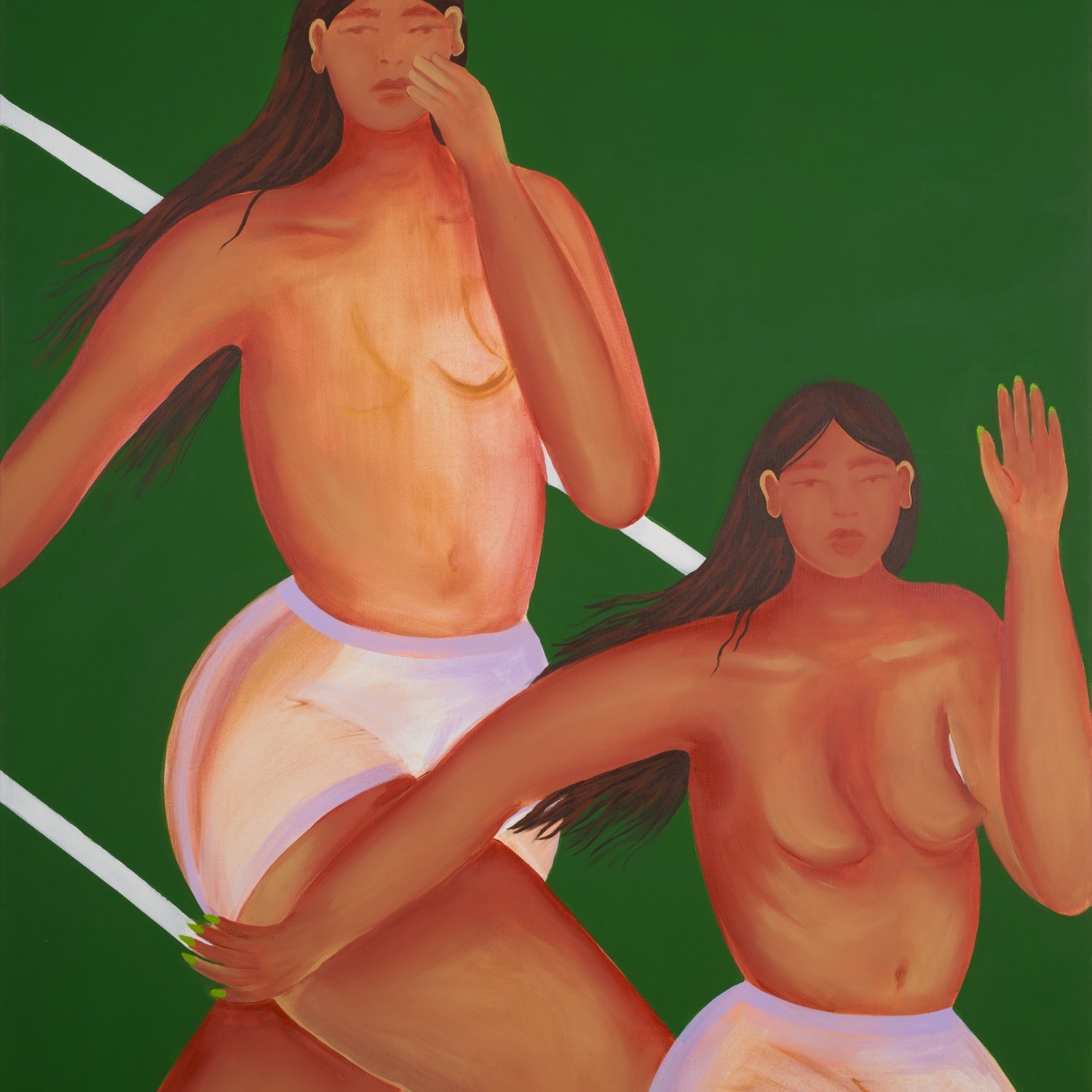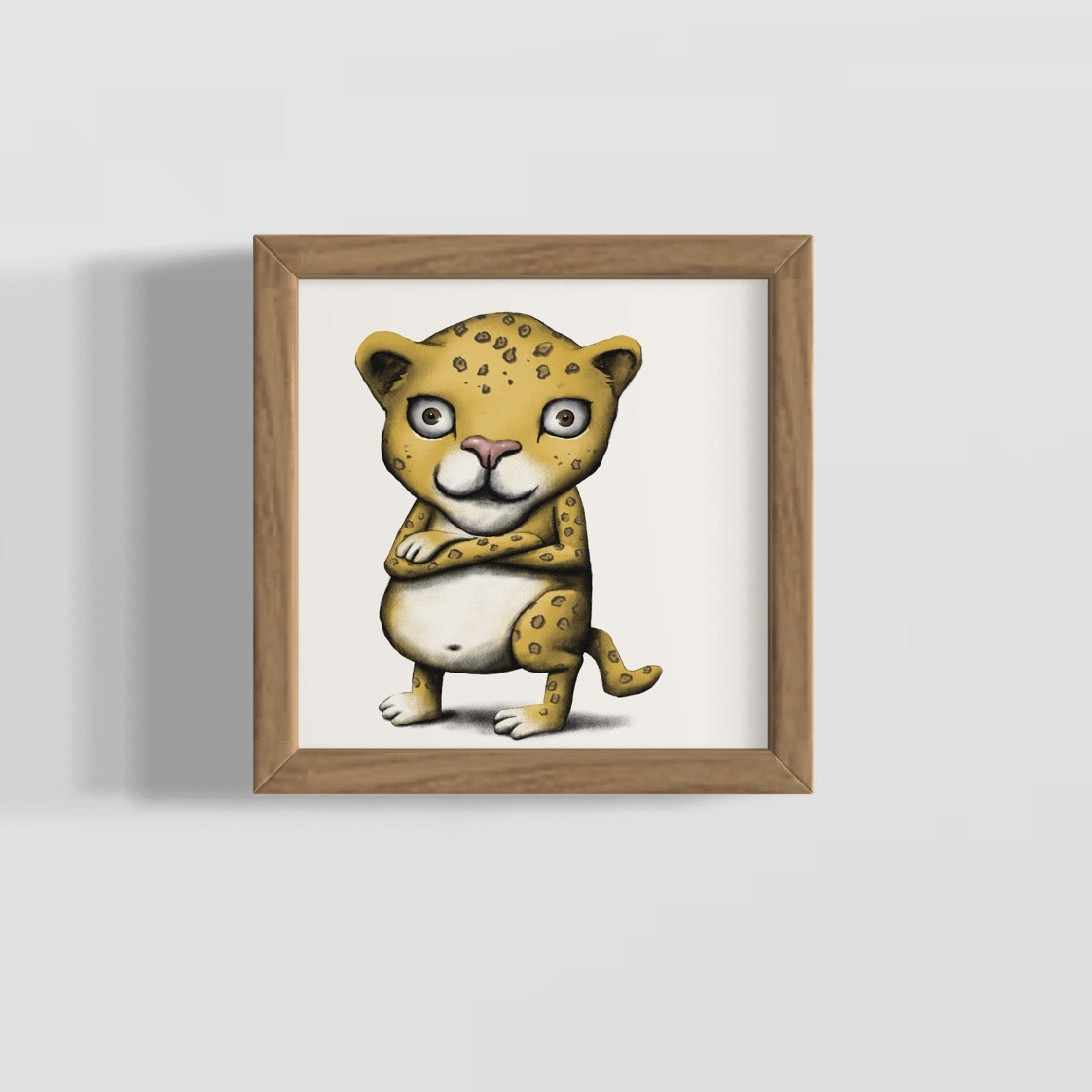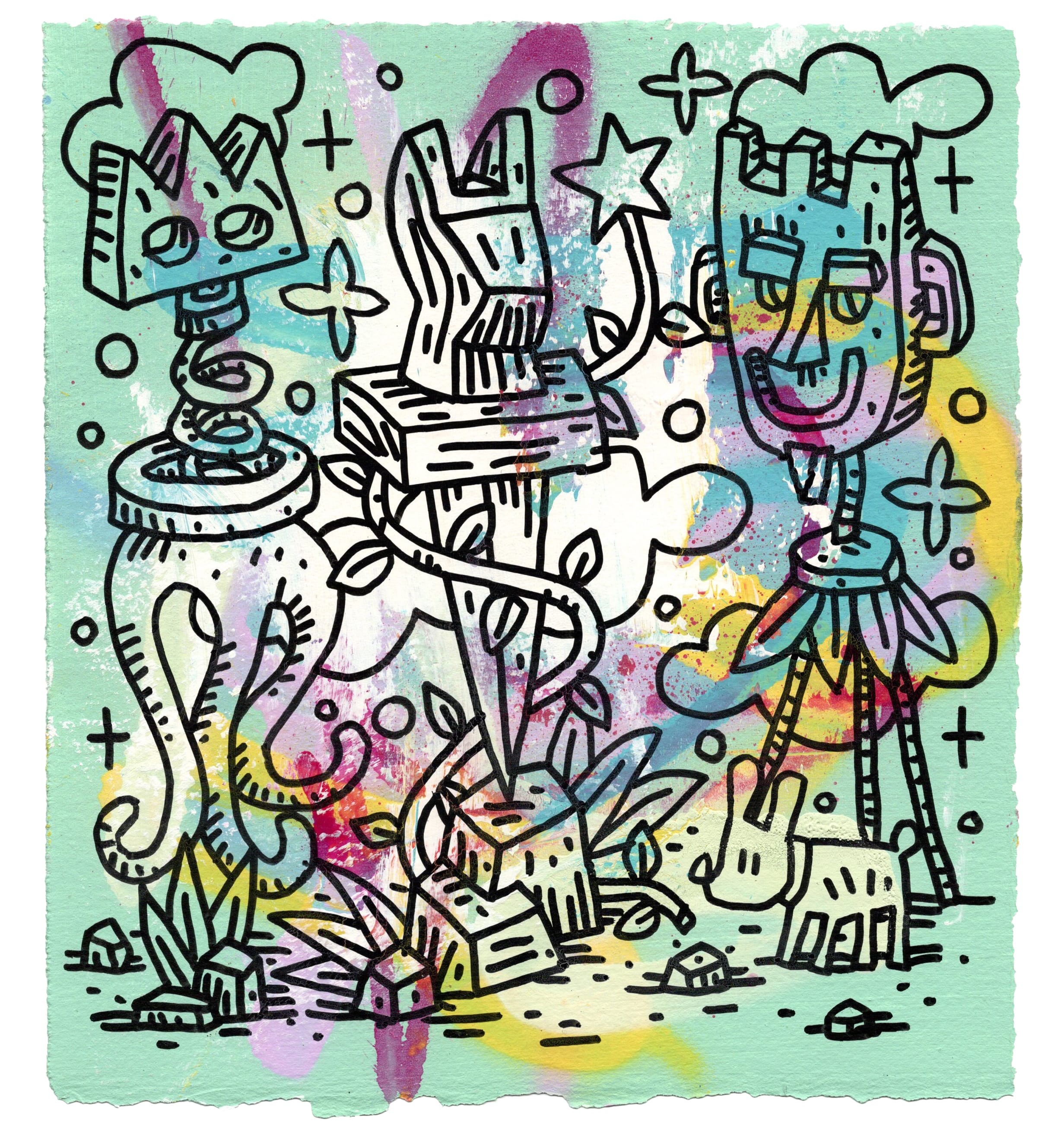

DISCOVER SPEEDY GRAPHITO’S UNIQUE ARTWORKS
SPEEDY GRAPHITO
Embark on a journey with Speedy Graphito, the French artist who has revolutionized street art. With his vibrant and colorful creations, Speedy Graphito's powerful art transcends traditional boundaries. Delve into his world of figurative art, where humor meets graffiti and street art. Discover his iconic character, Lapinture, and experience the undeniable energy of Speedy Graphito's artistic vision
With a fearless spirit and a brush in hand, Speedy Graphito transforms the mundane into extraordinary, inviting us to see the world through his kaleidoscope of creativity.
Filters
11 products
More information about the artist
Full catalogue, private viewing or questions about the artist

Speedy Graphito: A Kaleidoscope of Creativity and Evolution
As one of the pioneers of the French "Street art" movement, Olivier Rizzo, known by his alias Speedy Graphito, left an indelible mark on an entire generation with his innovative and impactful style in the early 1980s. Speedy Graphito views art as a life experience, exploring its various facets and fearlessly questioning his own artistic identity. His artistic styles are diverse, unveiling worlds where the artist, guided by instinct, loves to lose himself in search of possible evolution.
From public pictorial performances to the intimate space of his studio, Speedy Graphito wholeheartedly dedicates himself to his passion, fueled by the urgency of passing time. His exhibitions, organized thematically, follow one another, always offering new and surprising propositions. His trademark is that of a free artist, embodying joyful and profound art, often characterized by vibrant colors that breathe life into his figurative and city-inspired creations. With a touch of humor, Speedy Graphito playfully challenges our systems of perception, creating powerful and thought-provoking artworks.

Speedy Graphito: Redefining Urban Art and Inspiring Cultural Shifts
After studying art at the Estienne School in Paris and a brief career as an advertising graphic designer, Speedy Graphito joined the X-Moulinex collective in 1983, only to leave it the following year. To express and share his art, he took to the streets of Paris, covering them with graffiti executed through stencils or brushes, featuring stylized and dynamic figures such as Zulu warriors.
The year 1985 marked a decisive turning point in his career. He participated in the first gathering of the graffiti and urban art movement in Bondy, initiated by VLP, alongside Miss Tic, Jef Aérosol, SP 38, Banlieue-Banlieue, Blek le Rat, Futura 2000, Nuklé-Art, Epsylon Point, and more. That same year, he won a poster competition organized by the Ministry of Culture for "Le mois au Musée" with his artwork, "La ruée vers l'art" (a rearing horseback rider), which immediately propelled him into the spotlight.
Speedy Graphito's artistic imagery, including his iconic red imps (commercialized as postcards) and his beloved character, Lapinture, became widely recognized. Speedy Graphito explores various mediums, and his artworks take on different forms. While painting remains his preferred medium, he delves into sculpture, photography, video art, and digital art (such as "Welcome to Venus" in 2000).
As a born performer, he also paints numerous walls and canvases live during festivals, fairs, auctions, and exhibitions. The artist reinvents himself over time, always attuned to society and its evolving manifestations. The omnipresence of the internet, advertising brands, and consumerism become his muses. He draws inspiration from popular culture, the collective memory of the people, including pop iconography, comics, Disney, and even video games. Outdated artifacts from this "pop culture" find a renewed sense of life in a contemporary universe shaped by Speedy Graphito's artistic vision.
Currently, Speedy Graphito embarks on a new period, drawing inspiration from masters such as Van Gogh, Mondrian, Dalí, Miró, who ignited his love for art. He pays homage to them by incorporating their works into his own paintings and personal culture. The painter mixes styles, techniques, and artistic movements that have shaped him, creating his own narrative of art history.
In 2014, he exhibited alongside Jean-Jacques Deleval and Errò at the Arsenal de Soissons. In 2016, he achieved his record-breaking public auction sale in Paris, confirming that urban art plays a significant role in the contemporary art market. In the same year, he made his museum debut with a retrospective at the Musée du Touquet, followed by another retrospective at the Palais du Tau, a French National Monument. The future holds even more possibilities and opportunities for this remarkable contemporary artist.
Speedy Graphito: A Kaleidoscope of Creativity and Evolution
As one of the pioneers of the French "Street art" movement, Olivier Rizzo, known by his alias Speedy Graphito, left an indelible mark on an entire generation with his innovative and impactful style in the early 1980s. Speedy Graphito views art as a life experience, exploring its various facets and fearlessly questioning his own artistic identity. His artistic styles are diverse, unveiling worlds where the artist, guided by instinct, loves to lose himself in search of possible evolution.
From public pictorial performances to the intimate space of his studio, Speedy Graphito wholeheartedly dedicates himself to his passion, fueled by the urgency of passing time. His exhibitions, organized thematically, follow one another, always offering new and surprising propositions. His trademark is that of a free artist, embodying joyful and profound art, often characterized by vibrant colors that breathe life into his figurative and city-inspired creations. With a touch of humor, Speedy Graphito playfully challenges our systems of perception, creating powerful and thought-provoking artworks.
Speedy Graphito: Redefining Urban Art and Inspiring Cultural Shifts
After studying art at the Estienne School in Paris and a brief career as an advertising graphic designer, Speedy Graphito joined the X-Moulinex collective in 1983, only to leave it the following year. To express and share his art, he took to the streets of Paris, covering them with graffiti executed through stencils or brushes, featuring stylized and dynamic figures such as Zulu warriors.
The year 1985 marked a decisive turning point in his career. He participated in the first gathering of the graffiti and urban art movement in Bondy, initiated by VLP, alongside Miss Tic, Jef Aérosol, SP 38, Banlieue-Banlieue, Blek le Rat, Futura 2000, Nuklé-Art, Epsylon Point, and more. That same year, he won a poster competition organized by the Ministry of Culture for "Le mois au Musée" with his artwork, "La ruée vers l'art" (a rearing horseback rider), which immediately propelled him into the spotlight.
Speedy Graphito's artistic imagery, including his iconic red imps (commercialized as postcards) and his beloved character, Lapinture, became widely recognized. Speedy Graphito explores various mediums, and his artworks take on different forms. While painting remains his preferred medium, he delves into sculpture, photography, video art, and digital art (such as "Welcome to Venus" in 2000).
As a born performer, he also paints numerous walls and canvases live during festivals, fairs, auctions, and exhibitions. The artist reinvents himself over time, always attuned to society and its evolving manifestations. The omnipresence of the internet, advertising brands, and consumerism become his muses. He draws inspiration from popular culture, the collective memory of the people, including pop iconography, comics, Disney, and even video games. Outdated artifacts from this "pop culture" find a renewed sense of life in a contemporary universe shaped by Speedy Graphito's artistic vision.
Currently, Speedy Graphito embarks on a new period, drawing inspiration from masters such as Van Gogh, Mondrian, Dalí, Miró, who ignited his love for art. He pays homage to them by incorporating their works into his own paintings and personal culture. The painter mixes styles, techniques, and artistic movements that have shaped him, creating his own narrative of art history.
In 2014, he exhibited alongside Jean-Jacques Deleval and Errò at the Arsenal de Soissons. In 2016, he achieved his record-breaking public auction sale in Paris, confirming that urban art plays a significant role in the contemporary art market. In the same year, he made his museum debut with a retrospective at the Musée du Touquet, followed by another retrospective at the Palais du Tau, a French National Monument. The future holds even more possibilities and opportunities for this remarkable contemporary artist.


Discover more art
Credentials
"SOLO SHOWS2022 "" Fantômes "" Musée Ingres Bourdelle - Montauban (FR)"" Femmes "" Galerie Barthelemy Bouscayrol - Biarritz (FR)"" I have a computer head "" Galerie Barthelemy Bouscayrol - Biarritz (FR)"" Une histoire de famille "" Espace culturel - Cuiseaux (FR)2021 "" Visite au musée "" Galerie Provost Hacker - Lille (FR)“ La comédie de la vie “ Kolly Gallery - Zurich (CH)"" Tout un monde en soi "" Galerie Martine Ehmer - Bruxelles (B)"" The urban shop at street corner "" Kolly Gallery - Zurich (CH)"" Mondes imaginaires "" Musée en herbe Paris (FR)2020 "" Tout un monde en soi "" Galerie Huberty et Breyne - Bruxelles (B)"" The urban shop at street corner "" Kolly Gallery - Zurich (CH)""Speedy Graphito par Speedy Graphito "" Galerie polaris - Paris (FR)2019 "" Connivences "" Galerie Barthelemy Bouscayrol - Biarritz (FR)""Urban Republique "" Galerie Art Five - Marseille - (FR)""Beyond the future "" Fabien Castanier Galllery - Miami (US)""Le musée imaginaire "" Hotel départemental des arts - Toulon (FR)2018 "" Speedy Graphito au Palais du Tau "" Palais du Tau - Reims (FR)"" Out of Ages "" Galerie Provost Hacker – Lille (FR)"" Urban Fever "" Institut Culturel Bernard Magrez – Bordeaux (FR)"" L’art dans la peau"" Kolly Gallery - Zurich (CH)2017 “ Un Monde de Rêves“ Galerie Polaris– Paris (FR)"" Big Buzz Show "" Espace d'art Contemporain André Malraux - Colmar (FR)“ Retrospective d'édition d'art "" Centre d'art graphique - La Métairie Bruyère (FR)"" Speedy Graphito à l'État Sauvage "" Médiathèque Xaintrie Val'Drodogne - Argentat (FR)“ Fusion “ Kolly Gallery – Zurich – (CH)“ An American Story “ Fabien Castanier Gallery – Miami – (US)2016 "" Un Art de Vivre "" Musée du Touquet Paris Plage (FR)“ Face à Face“ New Square Gallery – Lille (FR)“ Home Street Home“ Galerie Huberty Breyne – Bruxelles (B)“ Sans motif apparent “ Espace ECART – Paris – (FR)“ Comme un vent de Liberté “ Galerie Barthelemy Bouscayrol– Biarritz – (FR)2015 “ Artificial Paradise“ Castanier Gallery – LA (US)“ Resolution “ Galerie Polaris – Paris(FR)“ Solo Show “ New Square Gallery – Lille (FR)2014 « Neverland “ Arsenal de Soissons - Soissons (FR)“ Libre comme l’art “ Hotel Jules et Jim – Paris (FR)“ Drawing now “ Galerie Polaris – Paris (FR)“ Hypnotic “ Castanier Gallery – Miami (US)“ Langages “ Artothèque de Pessac (FR)“ Parade “ Galerie Bertheas - Saint-Etienne (FR)2013 “ Start Over “ - Galerie Polaris - Paris ( FR )“ NEWWORLDS “ Fabien Castanier Gallery - L.A ( US )“ The Essential of Painting 1987 - 2013 “ à Saint-Emilion - Galerie Polaris hors les murs ( FR )“ Lost “ Maison Triolet - Aragon - Saint Arnoult en Yvelines ( FR )2012 “ LIKE “ New Square Gallery - Lille ( FR )“ The Essential of Painting 1987 - 2012 “ Galerie Polaris - Paris ( FR )2011 “ Solo Show “ Opera Gallery Londres ( UK )“ Back2Venus “ New Square Gallery Lille ( FR )“ Freeway “ Fabien Castanier Gallery - L.A ( US )“ Exit “ Galerie australe - La Réunion ( Dom Tom )“ Exit 2 ” Galerie 8 - Vichy ( FR )2010 “ What Did You Expect ? “ Galerie Brugier Rigail - Paris ( FR )“ Mondovision “ Artop - Lille ( FR )2009 “ Prime Time “ Art Partner Galerie - Bruxelles ( BE )2008 “ Sans Issues “ Art Partner Galerie - Paris ( FR )“ Voyage aux pays des merveilles “ CAC - Fontenoy ( FR )2007 “ Connexions “ Art Partner Galerie - Paris ( FR )“ Lille aux Trésors “ Artop - Lille ( FR )“ Urban Pop “ Ambrogi & Castanier Gallery - W- Hollywood ( US )2006 “ Tatouages Urbains “ Galerie Anne Vignial - Paris ( FR )“ Retro Prospective “ Galerie Suty - Coye la Forêt ( FR )2005 “ Parcours de La Bièvre “ Lézart de la Bièvre - Paris ( FR )2004 “ L’aventure Intérieure ” Espace Beaurepaire - Paris ( FR )“ Terminus ” La Chapelle du Carmel - Chalon s/ Saône ( FR )2003 “ Wake Up ” Galerie Polaris - Paris ( FR )2002 “ Voyages en terres inconnues ” L’atelier d’artiste chez vous - Paris ( FR )1998 “ Welcome to Vénus ” Galerie Polaris - Paris ( FR )1997 “ LAPINTURE ” Galerie Hugues de Payns - Tours ( FR )1996 “ L’être ou ne Palette ” Espace St Jacques - Saint Quentin ( FR )1995 “ C’est Moi qui Lapin, Sétois qui Voit ” Galerie Beau Lézard - Sète ( FR )“ La Vie dont je suis le Héros ” Galerie Polaris - Paris ( FR )1994 “ Que Passa ” Galerie Punto - Valencia (ES)“ Viva Lapinture ” Galerie Italia - Alicante (ES)1993 “ Le Monde Alaloupe “ Galerie Polaris - Paris ( FR )FIAC “ One Man Show ” Galerie Polaris - Paris ( FR )1992 FIAC “ One Man Show ” Galerie Polaris - Paris ( FR )1991 “ Paris, Tours, Rennes ” Galeries Polaris, Michel Pommier, Collin ( FR )1990 “ Speedy Graphito, Produit de l'Art” Espace Action - Paris ( FR )“ SG Peint l’Art Moderne de 1990 à nos jours ” Galerie Polaris - Paris ( FR )1989 “ King Of The City ” Galerie Polaris - Paris ( FR )1988 “ Étude Des Saints ” Galerie Polaris - Paris ( FR )1987 “ Le Radeau des Médusés ” Espace Action - Paris ( FR )“ LAPINTURE au Génie ” Galerie Wanet - Charleroi (BE)1986 “ L’atelier de L’artiste ” Galerie Polaris - Paris ( FR )“ Génie Artistique ” Institut Français - Naples (IT)1985 “ A La Recherche de Zarzan ” Galerie Paradis - Paris ( FR )“ Meurtre dans un Château Anglais ” Galerie Polaris - Paris ( FR )GROUP SHOWS2022 "" Les pionniers du Street Art "" Institut culturel Bernard Magrez - Bordeaux - (FR)"" La ville devant soi "" L’atelier 21 - Casablanca (MAR)2021 "" Spring Time "" Galerie Provost hacker - Lille (FR)"" Urban Republique II "" Galerie Art Five - Marseille - (FR)"" Prisme "" Magnetic Art Lab - Bordeaux - (FR)2020 ""L egends "" Galerie Art Five - marseille (FR)2019 "" Urban Republique "" Galerie Art Five - Marseille - (FR)2018 "" Une Vie de Livres et D'Art "" Le MUDO, Musée de l'Oise - Beauvais (FR)2017"" Volume "" Galerie Mathgoth - Paris (FR)"" Popadelic "" Fabien Castanier Gallery - Miami (US)"" Libres Figurations Année 80 "" Fonds Hélène et Édouard Leclerc - Landerneau (FR)2016 "" Who's your Daddy "" Kolly Gallery - Lausanne (CH)« Street Art Generation » Galerie Bertheas –Saint-Etienne (FR)« Street Art Show » Opera Gallery Paris – Monaco2015 « Urban Art 2015 » Biennale de Street art. Vôlklingen – Germany« Il sole è cieco » Galerie Polaris – Paris« Crânes-Icône.Mythe. Culte » Vôlklingen – Germany2014 « In situ » Fabien Castanier Gallery – Los Angeles« Boom » Epinal – France« Dali fait le mur » Espace Dali – paris - France2013 “ A4 “ New Square Gallery - Lille ( FR )""Urban Art Biennale 2013"" - Völklingen ( D )2012 “ Quelques instants plus tard ” Couvent des Cordeliers - Paris ( FR )“ Biennale du Havre “ Le Havre ( FR )“ Graff the peace” Opera Gallery - Paris ( FR )“ French Invasion ” Fabien Castanier Gallery - L.A ( US )“ Fifty Fifty ” Galerie Mathgot - Paris ( FR )2011 “ Graff ‘City “ Opera Gallery - Paris ( FR )“ Urban Activity “ Espace Culturel Jean Cocteau - Les Lilas ( FR )“ Fondation Clément “ Mix Art - La Martinique ( Dom Tom )“ Atrium “ Mix Art - La Martinique ( Dom Tom )2009 “ Stepanska Street Art “ Institut Français - Prague (CZ)“ No Man’s Land ” Ambassade De France - Tokyo (JP)2008 “ Group Show “ Art Partner Galerie - Bruxelles ( BE )“ Group Show “ Art Partner Galerie - Paris ( FR )2007 “ Group Show “ Art Partner Galerie - Paris ( FR )2006 “ Sur Les Murs “ Centre Culturel Français - Tlemcen (DZ)“ Aux Arts Citoyens “ Espace des Blancs Manteaux - Paris ( FR )“ Artistes Urbains “ Galerie Anne Vignial - Paris ( FR )“ Trend marks “ Galerie Suty - Coye La Forêt ( FR )“ Avant Travaux “ Usines Mauchauffée - Troyes ( FR )2005 “ Deck ‘On ” Exposition Itinérante Montpellier, Paris, Alpe d’Huez, Bienne…Exposition Itinérante Montpellier, Paris, Alpe d’Huez, Bienne… ( FR - CH )“ Section Urbaine ” Les Blancs Manteaux Paris ( FR )“ Rue Des Artistes ” Galerie Anne Vignial - Paris ( FR )“ Dites 33 ” La Condition Publique - Roubaix ( FR )2004 La Nuit Blanche “ Les Muutants ” Péniche Antipode - Paris ( FR )“ Les Muutants 2 ” Péniche Antipode - Paris ( FR )“ Voeux d’artistes ” Galerie Kahn - Paris ( FR )“ Paf dans ton Pif ” Hommage à Pif Gadget - Paris ( FR )“ Art de Rue ” Espace Tiffaine - Paris ( FR )“ Stencil Project ” Arslonga Paris ( FR )“ Portraits Incognitos ” Galerie Sanguine Paris ( FR )2003 “ Le Musée Idéal ” Espace Beaurepaire - Paris ( FR )“ Ma Collection Préférée ” Espace Beaurepaire - Paris ( FR )“ Art De Rue ” Galerie Kahn - Strasbourg ( FR )2001 “ General Motors ” Fondation Colas - Paris ( FR )1999 “ Artistes de la Galerie ” Galerie Polaris - Paris ( FR )1997 “ Exposition de groupe ” Galerie Du Chal - Saint Brieuc ( FR )1995 THE NEW PIER SHOW Galerie Punto - Madrid ( ES )“ Les Sirènes ” Musée De Dieppe - ( FR )1994 “ Un Artiste invite un Artiste ” Galerie Polaris - Paris ( FR )“ Les Déjeuners sur l’Herbe » Galerie Beau Lézard Sète - Paris - Séoul - Tokyo1993 “ Oeuvres Monumentales ” Galerie Polaris - Paris ( FR )1992 “ Comme convenu lors de … ” Galerie Polaris - Paris ( FR )“ Figurations, Fin de Millénaire ” Exposition Itinérante“ 5 ans d’édition 1987 - 1992 ” Galerie Polaris - Paris ( FR )1991 “ Exposition de groupe ” Galerie Métropolis - Lyon ( FR )“ Exposition de groupe ” Galerie Michel Pommier - Tours ( FR )“ Pour Saluer le Destin ” Musée d’Ingres - Montauban ( FR )1990 FIAC “ Artistes de la Galerie ” Galerie Polaris - Paris ( FR )SAGA “ Artistes de la Galerie ” Galerie Polaris - Paris ( FR )“ Exposition de groupe ” Galerie Patrick Riquelme - Vannes ( FR )1989 “ Le Témoignage de la Peinture 1789-1989 ” CAC - Avranches ( FR )1987 “ Les Allumés de La Télé ” Grande Halle de la Villette - Paris ( FR )1986 “ Les Media Peintres ” Maison de la Culture - Rennes ( FR )“ Peintures Sauvages ” Frasso Télésino Italie ( IT )1985 “ La Boutique à Speedy ” Galerie Polaris - Paris ( FR )“ Émotions ” Espace St Jacques - Saint Quentin ( FR )“ Mouchoirs d’artistes ” Galerie Lara Vinci - Paris ( FR )“ Détournement d’affiches ” CNAP - Paris ( FR )1984 “ Et Dans Dix Ans Qui ? ” Espace Cardin - Paris ( FR )"

























